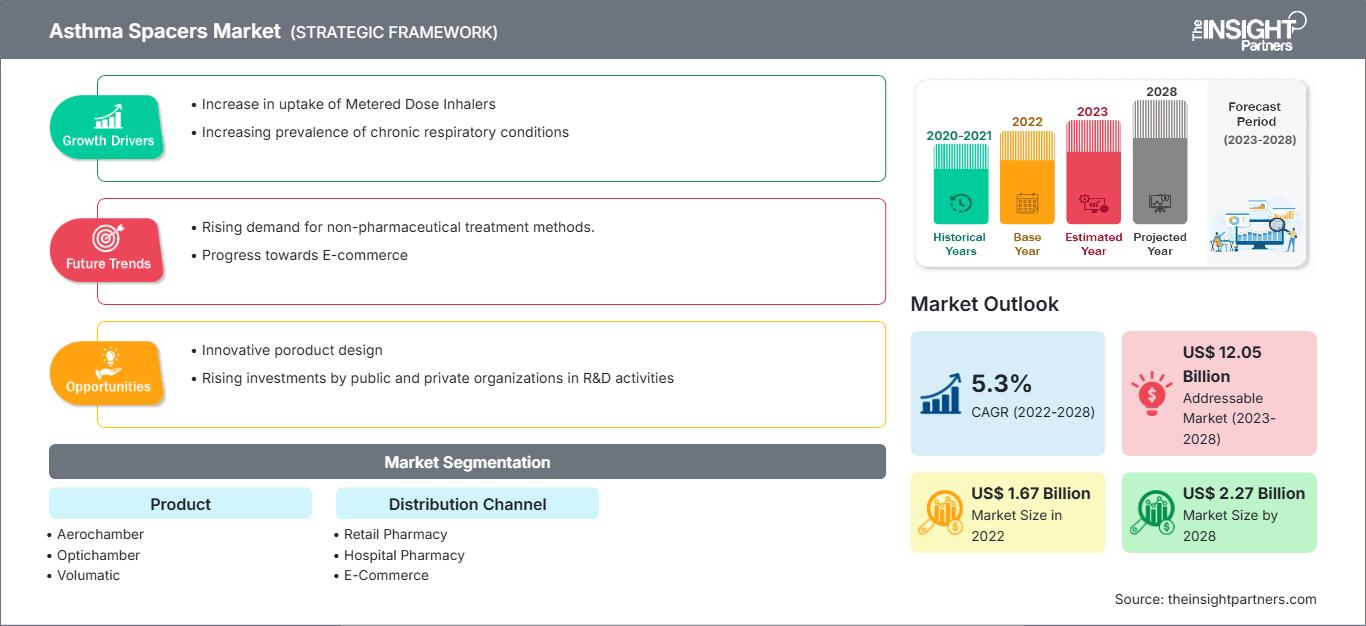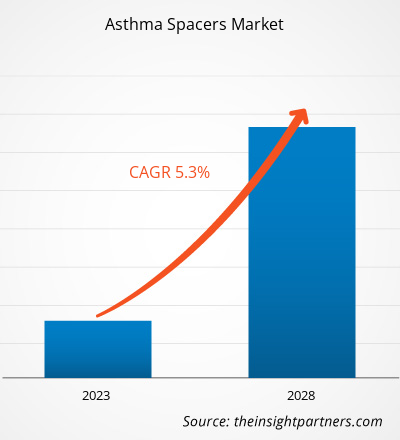Se proyecta que el mercado de espaciadores para el asma crecerá de US$ 1.666,48 millones en 2022 a US$ 2.266,47 millones en 2028; se estima que crecerá a una CAGR del 5,3% entre 2022 y 2028.
Los espaciadores para el asma son dispositivos externos que mejoran la administración del fármaco al aumentar la inhalación y la activación. Cuando se utilizan junto con el inhalador de dosis medida (IDM), ayudan a administrar la cantidad correcta de medicamento a los pulmones. Su uso ayuda a reducir el desperdicio de medicamento y a limitar la aparición de efectos adversos relacionados con la dosis. El asma es una enfermedad respiratoria crónica que afecta las vías respiratorias con síntomas variables y recurrentes, como opresión en el pecho, dificultad para respirar, sibilancias y tos. En la mayoría de los casos, es muy difícil distinguir el asma de la EPOC en pacientes de edad avanzada debido a las características clínicas similares, mientras que la recurrencia del asma es un problema importante en pacientes más jóvenes. Los factores genéticos influyen considerablemente en el desarrollo de la enfermedad.
El crecimiento del mercado de espaciadores para el asma se atribuye a la creciente prevalencia de enfermedades respiratorias crónicas, la mayor concienciación sobre sus beneficios y el aumento de la inversión de organizaciones públicas y privadas en I+D para la innovación de productos. Sin embargo, el aumento de los costos de estos dispositivos y la falta de conocimiento del producto por parte de la población están frenando el crecimiento del mercado.
Recibirá personalización de cualquier informe, sin cargo, incluidas partes de este informe o análisis a nivel de país, paquete de datos de Excel, y además aprovechará grandes ofertas y descuentos para empresas emergentes y universidades.
Mercado de espaciadores para el asma: Perspectivas estratégicas

- Obtenga las principales tendencias clave del mercado de este informe.Esta muestra GRATUITA incluirá análisis de datos, desde tendencias del mercado hasta estimaciones y pronósticos.
El mercado de espaciadores para el asma está segmentado por producto, canal de distribución y ubicación geográfica. Según la geografía, se segmenta ampliamente en Norteamérica, Europa, Asia Pacífico, Oriente Medio y África, y Sudamérica y Centroamérica. El informe sobre el mercado de espaciadores para el asma ofrece información y un análisis exhaustivo del mercado, destacando parámetros como el tamaño, las tendencias, los avances tecnológicos y la dinámica del mercado. El informe también incluye el análisis del panorama competitivo de los principales actores del mercado de espaciadores para el asma a nivel mundial. Además, incluye el impacto de la pandemia de COVID-19 en el mercado de espaciadores para el asma en todas las regiones.
Perspectivas del mercado:
Aumento de la demanda debido a la creciente adopción de inhaladores de dosis medida
La creciente prevalencia de enfermedades respiratorias, como el asma y la EPOC, genera oportunidades lucrativas para la adopción de inhaladores de dosis medida. Por ejemplo, según un estudio publicado por un grupo de investigadores del Departamento de Medicina Pulmonar y de Cuidados Críticos de la Clínica Mayo, en 2020 se prevé que el número de casos de asma alcance casi el 52,0 % en los próximos 20 años en EE. UU. Además, según el mismo estudio, se prevé que el gasto en el tratamiento del asma en EE. UU. alcance los 963 000 millones de dólares estadounidenses para 2038, lo que impulsará el crecimiento de la adopción de inhaladores de dosis medida y, con el tiempo, acelerará la adopción de inhaladores y espaciadores durante el período previsto. Paralelamente, los casos de asma en Europa también están en constante aumento. Además, más de 30 millones de niños y adultos menores de 45 años viven actualmente con asma en Europa, según datos del Libro Blanco Europeo del Pulmón. Entre todos los países europeos, el Reino Unido, España e Irlanda presentan algunas de las tasas de asma más altas.
Además, las autoridades gubernamentales y las instituciones sanitarias están implementando diversos programas para concienciar sobre el asma y prevenir la morbilidad causada por esta enfermedad. El Programa Nacional para el Control del Asma (NACP), impulsado por los Centros para el Control y la Prevención de Enfermedades (CDC), trabaja continuamente para concienciar sobre el asma y frenar la enfermedad. Estos programas están impulsando la adopción de inhaladores, lo que, a su vez, impulsa el mercado.
Los espaciadores desempeñan un papel fundamental en la administración de medicamentos a las vías respiratorias. Sin embargo, en algunos casos, los pacientes enfrentan dificultades al usarlos debido a su tamaño y diseño. Por ejemplo, según un estudio realizado por Trudell Medical, una de las empresas líderes del mercado en 2019, la mayoría de los pacientes se sienten incómodos al usarlos debido a su tamaño y diseño. Para abordar este problema, los actores del mercado se están centrando en el diseño, que facilita su transporte y ofrece un tratamiento eficaz para las afecciones respiratorias. Por lo tanto, los nuevos diseños y las características mejoradas están transformando el mercado estadounidense de espaciadores para el asma.
Perspectivas basadas en productos
Según el producto, el mercado de espaciadores para el asma se segmenta en aerocámaras, ópticas, volumáticas e inspirease. En 2022, se espera que las aerocámaras alcancen la mayor cuota de mercado y registren la mayor tasa de crecimiento anual compuesta (TCAC) entre 2022 y 2028.
Perspectivas regionales del mercado de espaciadores para el asma
Los analistas de The Insight Partners han explicado detalladamente las tendencias regionales y los factores que influyen en el mercado de espaciadores para el asma durante el período de pronóstico. Esta sección también analiza los segmentos y la geografía del mercado de espaciadores para el asma en América del Norte, Europa, Asia Pacífico, Oriente Medio y África, y América del Sur y Central.
Alcance del informe de mercado de espaciadores para el asma
| Atributo del informe | Detalles |
|---|---|
| Tamaño del mercado en 2022 | 1.670 millones de dólares estadounidenses |
| Tamaño del mercado en 2028 | US$ 2.27 mil millones |
| CAGR global (2022-2028) | 5,3% |
| Datos históricos | 2020-2021 |
| Período de pronóstico | 2023-2028 |
| Segmentos cubiertos | Por producto
|
| Regiones y países cubiertos | América del norte
|
| Líderes del mercado y perfiles de empresas clave |
|
Densidad de actores del mercado de espaciadores para el asma: comprensión de su impacto en la dinámica empresarial
El mercado de espaciadores para el asma está creciendo rápidamente, impulsado por la creciente demanda del usuario final debido a factores como la evolución de las preferencias de los consumidores, los avances tecnológicos y un mayor conocimiento de los beneficios del producto. A medida que aumenta la demanda, las empresas amplían su oferta, innovan para satisfacer las necesidades de los consumidores y aprovechan las tendencias emergentes, lo que impulsa aún más el crecimiento del mercado.

- Obtenga una descripción general de los principales actores clave del mercado de espaciadores para el asma
Información basada en canales de distribución
Según el canal de distribución, el mercado de espaciadores para el asma se segmenta en farmacias minoristas, farmacias hospitalarias y comercio electrónico. En 2021, el segmento de farmacias minoristas tuvo la mayor participación de mercado y se espera que registre la mayor tasa de crecimiento anual compuesta (TCAC) entre 2022 y 2028.
El lanzamiento y la aprobación de productos son estrategias comunes que adoptan las empresas para expandir su presencia global y su cartera de productos. Además, los actores del mercado de espaciadores para el asma se centran en la estrategia de asociación para ampliar su clientela, lo que, a su vez, les permite mantener su marca a nivel mundial. Se prevé que el mercado prospere en los próximos años gracias al desarrollo de productos innovadores por parte de los actores del mercado.
Perfiles de empresas:
Cipla Inc., PARI GmbH, Koninklijke Philips NV, Lupin, HAAG-STREIT GROUP, Laboratoire ProtecSom, Monaghan Medical Corporation, Koo Medical Equipment, Agaplastic, Metall Zug y Teleflex Incorporated se encuentran entre las empresas líderes que operan en el mercado mundial de espaciadores para el asma.
- Análisis histórico (2 años), año base, pronóstico (7 años) con CAGR
- Análisis PEST y FODA
- Tamaño del mercado, valor/volumen: global, regional y nacional
- Industria y panorama competitivo
- Conjunto de datos de Excel
Informes recientes
Testimonios
Razón para comprar
- Toma de decisiones informada
- Comprensión de la dinámica del mercado
- Análisis competitivo
- Información sobre clientes
- Pronósticos del mercado
- Mitigación de riesgos
- Planificación estratégica
- Justificación de la inversión
- Identificación de mercados emergentes
- Mejora de las estrategias de marketing
- Impulso de la eficiencia operativa
- Alineación con las tendencias regulatorias






















 Obtenga una muestra gratuita para - Mercado de espaciadores para el asma
Obtenga una muestra gratuita para - Mercado de espaciadores para el asma